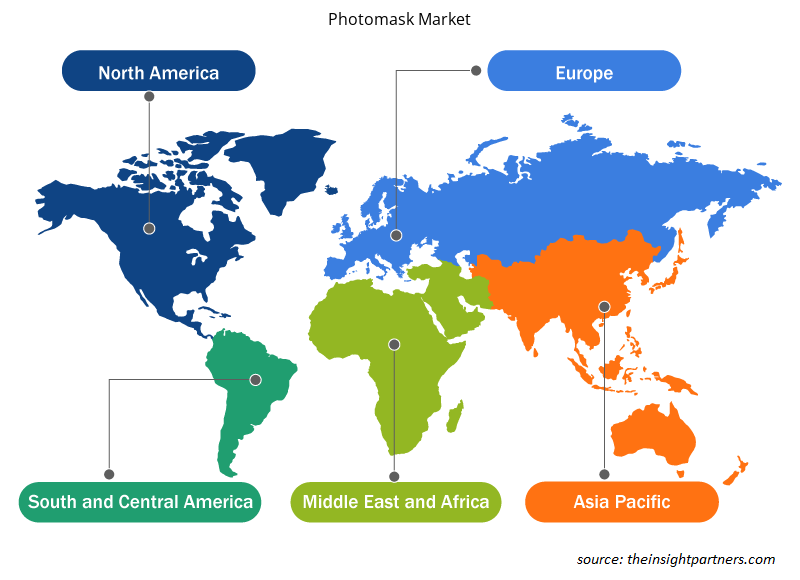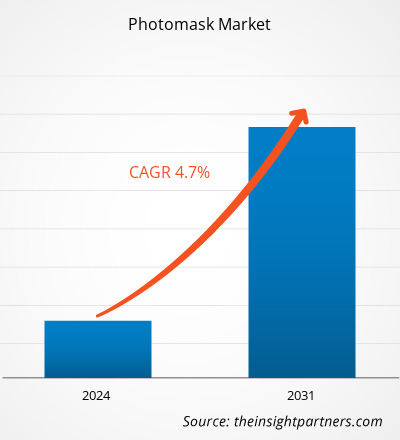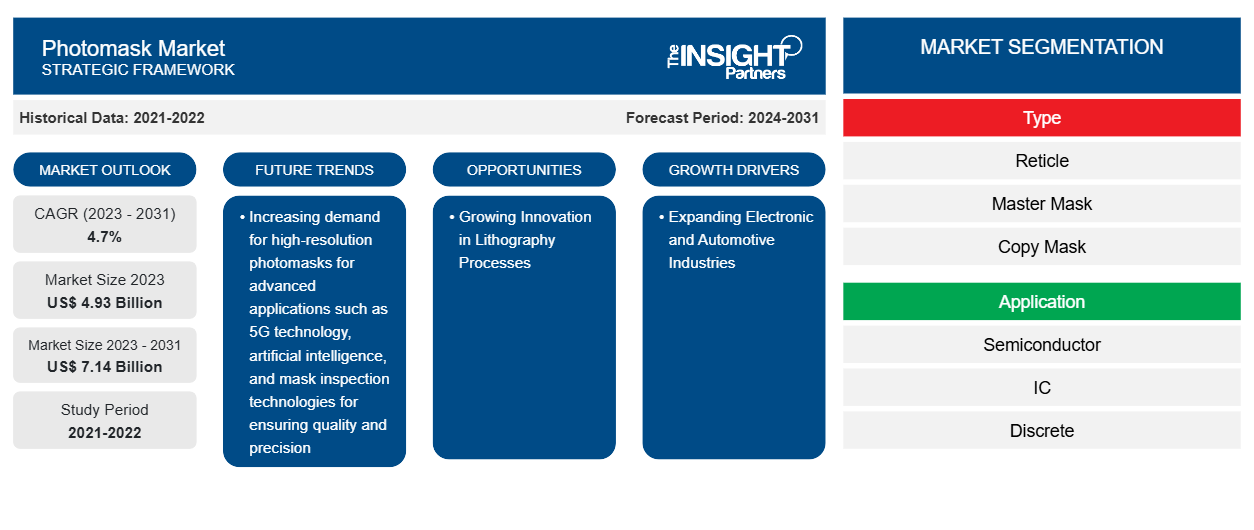Der Markt für Fotomasken soll von 4,93 Milliarden US-Dollar im Jahr 2023 auf 7,14 Milliarden US-Dollar im Jahr 2031 anwachsen. Der Markt soll in den Jahren 2023–2031 eine durchschnittliche jährliche Wachstumsrate (CAGR) von 4,7 % verzeichnen. Die steigende Nachfrage nach hochauflösenden Fotomasken für fortschrittliche Anwendungen wie 5G-Technologie, künstliche Intelligenz und Maskeninspektionstechnologien zur Gewährleistung von Qualität und Präzision dürfte ein wichtiger Trend auf dem Fotomaskenmarkt bleiben.
Fotomasken-Marktanalyse
Der Markt für Fotomasken wächst aufgrund der expandierenden Elektronik- und Automobilindustrie und der steigenden Nachfrage nach schnellen Computerspeichern und Prozessoren rasant. Der Markt wächst stetig, angetrieben durch die zunehmende Verbreitung moderner Halbleiterbauelemente. Darüber hinaus bieten die zunehmende Innovation bei Lithografieprozessen und die steigende Produktion technologisch fortschrittlicher Automobile lukrative Möglichkeiten für Marktwachstum.
Marktübersicht für Fotomasken
Fotomasken sind Bildübertragungswerkzeuge, die durch Belichten oder Zeichnen eines Musters auf einem mit Resist beschichteten Chromrohling hergestellt werden. Sie bestehen aus festen, transparenten Substraten mit einer opaken Oberflächenschicht. Fotomasken enthalten das IC-Layout, das dupliziert werden muss. Fotomasken werden immer beliebter, um Muster präzise auf Siliziumscheiben zu übertragen , da Transistoren immer kleiner und fortschrittlicher werden. Darüber hinaus treibt der wachsende Bedarf an Fotomasken zur Herstellung komplizierter integrierter Schaltkreischips den Markt an.
Passen Sie diesen Bericht Ihren Anforderungen an
Sie erhalten kostenlos individuelle Anpassungen an jedem Bericht, einschließlich Teilen dieses Berichts oder einer Analyse auf Länderebene, eines Excel-Datenpakets sowie tolle Angebote und Rabatte für Start-ups und Universitäten.
-
Holen Sie sich die wichtigsten Markttrends aus diesem Bericht.Dieses KOSTENLOSE Beispiel umfasst eine Datenanalyse von Markttrends bis hin zu Schätzungen und Prognosen.
Treiber und Chancen auf dem Fotomaskenmarkt
Expandierende Elektronik- und Automobilindustrie treibt den Markt an
Der weltweite Elektroniksektor erlebt aufgrund der gestiegenen Verbrauchernachfrage nach elektronischen Geräten, technologischer Fortschritte und der Einführung des Internets der Dinge und tragbarer Technologien ein außerordentliches Wachstum. Die International Trade Administration (ITA) prognostiziert, dass der weltweite Elektroniksektor bis 2025 voraussichtlich über 5 Billionen US-Dollar betragen wird, was Chancen für Halbleiterhersteller schafft und den Fotomaskenmarkt im Prognosezeitraum antreibt. Darüber hinaus treiben die expandierende Automobilindustrie und die steigende Nachfrage der Verbraucher nach Elektrofahrzeugen und autonomer Fahrtechnologie den Markt an. Die Verbraucher tendieren zunehmend in Richtung vernetzter Fahrzeuge und verbesserter Kommunikations- und Sicherheitssysteme, was die Entwicklung fortschrittlicher Halbleiterbauelemente stimuliert und so das Wachstum des Fotomaskenmarktes ankurbelt.
Wachsende Innovation bei Lithografieprozessen – eine Chance auf dem Fotomaskenmarkt
Wachsende Innovationen in der Lithografie sind entscheidend, um die Technologie zur Herstellung kompakter und komplizierter Halbleiterbauelemente mit verbesserter Leistung und Effizienz zu befähigen. Die Extrem-Ultraviolett-Lithografie (EUV) stellt einen bedeutenden technologischen Fortschritt in der Halbleiterindustrie dar. Laut der International Technology Roadmap of Semiconductors (ITRS) ist die Anzahl der gelieferten EUV-Werkzeuge im Jahr 2023 im Vergleich zu 2022 um bis zu 30 % gestiegen, was darauf hindeutet, dass die Industrie diese hochmoderne Lithografietechnologie schnell übernimmt. Die EUV-Lithografie ermöglicht geringere Strukturgrößen und eine höhere Auflösung, was zu einer verbesserten Chipleistung und Kosteneffizienz führt. Diese technischen Fortschritte ziehen Fotomasken an, die auf EUV-Lithografieanwendungen zugeschnitten sind, was im Prognosezeitraum voraussichtlich Marktchancen schaffen wird.
Segmentierungsanalyse des Fotomaskenmarktberichts
Wichtige Segmente, die zur Ableitung der Fotomaskenmarktanalyse beigetragen haben, sind Typ, Anwendung und Endbenutzerbranche.
- Basierend auf dem Typ ist der Fotomaskenmarkt in Retikel, Mastermasken und Kopiermasken unterteilt. Das Segment der Mastermasken hatte im Jahr 2023 einen größeren Marktanteil.
- Auf der Grundlage der Anwendung ist der Markt in Halbleiter und IC, diskrete Bauelemente, Optoelektronik, Anzeigegeräte, MEMS und andere unterteilt. Das Halbleiter- und IC-Segment hatte im Jahr 2023 einen größeren Marktanteil.
- In Bezug auf die Endbenutzer-Vertikale wird der Fotomaskenmarkt in Halbleiter & IC und Flachbildschirme unterteilt. Das Halbleiter- und IC-Segment hatte im Jahr 2023 einen größeren Marktanteil.
Fotomasken-Marktanteilsanalyse nach Geografie
Der geografische Umfang des Fotomaskenmarktberichts ist hauptsächlich in fünf Regionen unterteilt: Nordamerika, Asien-Pazifik, Europa, Naher Osten und Afrika sowie Südamerika/Süd- und Mittelamerika.
In Bezug auf den Umsatz hatte der asiatisch-pazifische Markt den größten Marktanteil bei Fotomasken, was auf die Präsenz einer riesigen Elektronikindustrie in China, Südkorea und Taiwan zurückzuführen ist. Das Wachstum der Elektronikindustrie erhöht die Nachfrage nach Fotomasken in der Halbleiterfertigung. Laut dem südkoreanischen Handelsministerium stiegen die Halbleiterexporte des Landes im ersten Quartal 2023 im Vergleich zum gleichen Zeitraum 2022 um 12 %. Die wachsende Nachfrage der Hersteller nach halbkontinuierlichen Halbleitern für die Produktion elektronischer Geräte und Vorrichtungen schafft in diesem Zeitraum Chancen für den Markt. Darüber hinaus tragen die Investitionen der Region in Technologie und Infrastrukturentwicklung erheblich zum Wachstum des globalen Fotomaskenmarktes bei.
Regionale Einblicke in den Fotomaskenmarkt
Die regionalen Trends und Faktoren, die den Fotomaskenmarkt während des Prognosezeitraums beeinflussen, wurden von den Analysten von Insight Partners ausführlich erläutert. In diesem Abschnitt werden auch die Marktsegmente und die Geografie von Fotomasken in Nordamerika, Europa, im asiatisch-pazifischen Raum, im Nahen Osten und Afrika sowie in Süd- und Mittelamerika erörtert.

- Erhalten Sie regionale Daten zum Fotomaskenmarkt
Umfang des Fotomasken-Marktberichts
| Berichtsattribut | Details |
|---|---|
| Marktgröße im Jahr 2023 | 4,93 Milliarden US-Dollar |
| Marktgröße bis 2031 | 7,14 Milliarden US-Dollar |
| Globale CAGR (2023 - 2031) | 4,7 % |
| Historische Daten | 2021-2022 |
| Prognosezeitraum | 2024–2031 |
| Abgedeckte Segmente |
Nach Typ
|
| Abgedeckte Regionen und Länder |
Nordamerika
|
| Marktführer und wichtige Unternehmensprofile |
|
Dichte der Marktteilnehmer für Fotomasken: Die Auswirkungen auf die Geschäftsdynamik verstehen
Der Markt für Fotomasken wächst rasant, angetrieben durch die steigende Nachfrage der Endnutzer aufgrund von Faktoren wie sich entwickelnden Verbraucherpräferenzen, technologischen Fortschritten und einem größeren Bewusstsein für die Vorteile des Produkts. Mit steigender Nachfrage erweitern Unternehmen ihr Angebot, entwickeln Innovationen, um die Bedürfnisse der Verbraucher zu erfüllen, und nutzen neue Trends, was das Marktwachstum weiter ankurbelt.
Die Marktteilnehmerdichte bezieht sich auf die Verteilung von Firmen oder Unternehmen, die in einem bestimmten Markt oder einer bestimmten Branche tätig sind. Sie gibt an, wie viele Wettbewerber (Marktteilnehmer) in einem bestimmten Marktraum im Verhältnis zu seiner Größe oder seinem gesamten Marktwert präsent sind.
Die wichtigsten auf dem Fotomaskenmarkt tätigen Unternehmen sind:
- Vorab-Reproduktionen Corporation
- Compugraphics International Limited
- Dai Nippon Printing Co., Ltd.
- HOYA Corporation
- LG Innotek Co., Ltd.
- Nippon Filcon Co., Ltd.
Haftungsausschluss : Die oben aufgeführten Unternehmen sind nicht in einer bestimmten Reihenfolge aufgeführt.

- Überblick über die wichtigsten Akteure auf dem Fotomaskenmarkt
Neuigkeiten und aktuelle Entwicklungen zum Fotomaskenmarkt
Der Fotomaskenmarkt wird durch die Erhebung qualitativer und quantitativer Daten nach Primär- und Sekundärforschung bewertet, die wichtige Unternehmensveröffentlichungen, Verbandsdaten und Datenbanken umfasst. Im Folgenden finden Sie eine Liste der Entwicklungen auf dem Markt für Fotomasken und Strategien:
- Im Februar 2024 gab Toppan Printing Co., Ltd. bekannt, dass es eine gemeinsame Forschungs- und Entwicklungsvereinbarung mit IBM in Bezug auf den 2-Nanometer-(nm)-Logikhalbleiterknoten unter Verwendung der Extrem-Ultraviolett-(EUV)-Lithografie geschlossen hat. Diese Vereinbarung umfasst auch die Entwicklungsfähigkeit von High-NA-EUV-Fotomasken für Halbleiter der nächsten Generation. (Quelle: Toppan Printing Co., Ltd., Pressemitteilung, 2023)
- Im Dezember 2023 entwickelte Dai Nippon Printing Co., Ltd. erfolgreich ein Fotomaskenherstellungsverfahren, das für das 3-Nanometer-Lithografieverfahren (10-9 Meter) geeignet ist und die Extrem-Ultraviolett-Lithografie (EUV) unterstützt, das modernste Verfahren für die Halbleiterherstellung. (Quelle: Dai Nippon Printing Co., Ltd., Pressemitteilung, 2023)
Abdeckung und Ergebnisse des Fotomasken-Marktberichts
Der Bericht „Marktgröße und Prognose für Fotomasken (2021–2031)“ bietet eine detaillierte Analyse des Marktes, die die folgenden Bereiche abdeckt:
- Marktgröße und Prognose auf globaler, regionaler und Länderebene für alle wichtigen Marktsegmente, die im Rahmen des Projekts abgedeckt sind
- Marktdynamik wie Treiber, Beschränkungen und wichtige Chancen
- Wichtige Zukunftstrends
- Detaillierte PEST/Porters Five Forces- und SWOT-Analyse
- Globale und regionale Marktanalyse mit wichtigen Markttrends, wichtigen Akteuren, Vorschriften und aktuellen Marktentwicklungen
- Branchenlandschaft und Wettbewerbsanalyse, einschließlich Marktkonzentration, Heatmap-Analyse, prominenten Akteuren und aktuellen Entwicklungen
- Detaillierte Firmenprofile
- Historische Analyse (2 Jahre), Basisjahr, Prognose (7 Jahre) mit CAGR
- PEST- und SWOT-Analyse
- Marktgröße Wert/Volumen – Global, Regional, Land
- Branchen- und Wettbewerbslandschaft
- Excel-Datensatz
Aktuelle Berichte
Erfahrungsberichte
Grund zum Kauf
- Fundierte Entscheidungsfindung
- Marktdynamik verstehen
- Wettbewerbsanalyse
- Kundeneinblicke
- Marktprognosen
- Risikominimierung
- Strategische Planung
- Investitionsbegründung
- Identifizierung neuer Märkte
- Verbesserung von Marketingstrategien
- Steigerung der Betriebseffizienz
- Anpassung an regulatorische Trends























 Kostenlose Probe anfordern für - Fotomaskenmarkt
Kostenlose Probe anfordern für - Fotomaskenmarkt